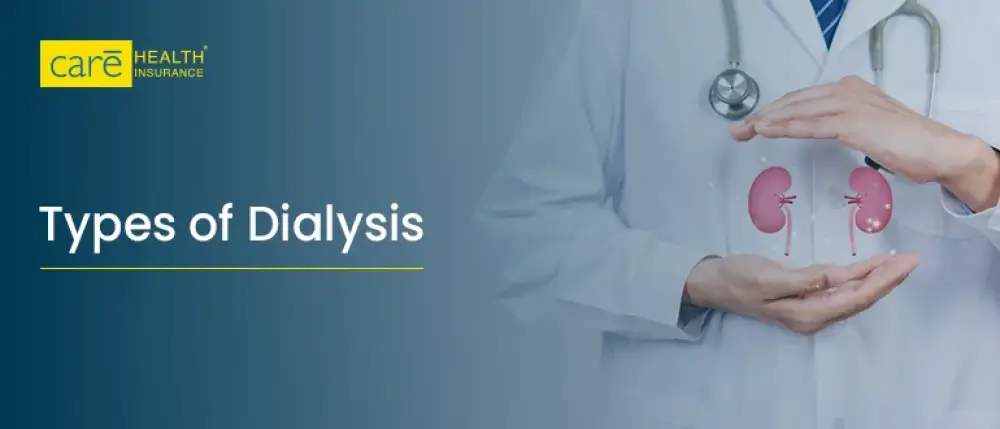Subscribe to get weekly insights
Always stay up to date with our newest articles sent direct to your inbox
Published on 7 Nov, 2025
Updated on 12 Nov, 2025
42 Views
6 min Read

Written by Leena Khowal
Reviewed by Ritika Malik
favorite0Like
favoriteBe the First to Like
When your kidneys can’t do their job of filtering waste and extra fluid, dialysis steps in as a life-saving support system. But did you know there’s more than one way to do dialysis? Yes, the treatment isn’t one-size-fits-all. Depending on your health, lifestyle, and doctor’s advice, you may be offered different types of dialysis. Each type has its own process, benefits, and challenges.
In this blog, we’ll walk you through what dialysis really means and explore the primary types—hemodialysis, peritoneal dialysis, and continuous renal replacement therapy (CRRT). We’ll explain how they work in simple terms, what to expect, and how each option can fit into your life. Whether you’re a patient, a caregiver, or simply curious, this guide will provide you with a clear understanding of dialysis and help you navigate your options.
Think of your kidneys as natural filters. They clean your blood, remove excess fluid, and maintain your body's balance. But when kidneys fail, waste and fluid start building up in the body—and that’s where dialysis steps in.
Sometimes dialysis is temporary (after an injury), and other times it becomes long-term (for chronic kidney disease).
There are several methods for performing dialysis. The main ones are:
Hemodialysis is like sending your blood to a washing machine and then bringing it back clean.
Here’s how it works:
Benefits Of Hemodialysis
Challenges Of Hemodialysis
Peritoneal dialysis is a method to clean your blood inside your body (as opposed to hemodialysis, which uses a machine). It utilises your abdominal lining (the peritoneum) to filter waste and excess fluid.
Types Of Peritoneal Dialysis
There are two main kinds. You or your doctor can choose the one that best fits your lifestyle.
Continuous Ambulatory Peritoneal Dialysis (CAPD)
Automated Peritoneal Dialysis (APD)
Where & How to Do It
Preparing for Peritoneal Dialysis
Challenges
Using peritoneal dialysis means some day-to-day changes. Here are things to expect:
How can you tell if it’s working?
CRRT is a type of dialysis used primarily in hospitals for critically ill patients, especially those in intensive care units. It’s designed to work slowly and continuously over 24 hours rather than in shorter pulses.
When to Prefer?
Here are some situations where doctors prefer CRRT:
Here’s how CRRT Works:
Some main features and how it differs from regular hemodialysis:
Benefits of CRRT
Challenges of CRRT
>>Read More: Going For Dialysis Learn How To Choose Health Insurance To Manage Dialysis Cost
Understanding the different types of dialysis helps you feel more prepared for your future consequences and keep your health journey under control. Hemodialysis, peritoneal dialysis, and CRRT each have their own processes, benefits, and challenges in critical care. Choosing the right option depends on your overall health, lifestyle, and your doctor's recommendations.
Dialysis isn’t just a treatment—it’s a lifeline for people whose kidneys can no longer perform their job. Since it often becomes a long-term part of life, it brings daily changes in daily routine, regular checkups, and ongoing expenses. That’s why having a reliable health insurance plan can ease the burden and give you the support you need along the way. Just as dialysis helps your body stay balanced, health coverage ensures your finances remain secure during treatment. Protecting your health and your peace of mind go hand-in-hand—and with the proper support, you can focus on living better, not just managing illness.
Disclaimer: All plan features, benefits, coverage, and claims underwriting are subject to policy terms and conditions. Kindly refer to the brochure, sales prospectus, and policy documents carefully.
favoriteBe the First to Like
Thyroid : मामूली नहीं हैं महिलाओं में थायराइड होना, जानें इसके लक्षण और घरेलू उपचार Vipul Tiwary in Diseases
शुगर कंट्रोल कैसे करे? जानें, डायबिटीज में क्या खाना चाहिए Vipul Tiwary in Health & Wellness
हाई ब्लड प्रेशर को तुरंत कंट्रोल कैसे करें? देखें इसके उपाय Vipul Tiwary in Diseases
पैरों में दर्द किस कमी से होता है? जानें, इसके घरेलू इलाज Vipul Tiwary in Health Insurance Articles
Understanding Azotemia: Meaning, Causes, Treatment & ICD 10 Guide Leena Khowal in Diseases
Two Significant types of home dialysis are Peritoneal Dialysis (PD), in which a special fluid is introduced into the abdomen to filter waste, and Home Hemodialysis (HHD), in which a machine cleans the blood through a dialyser.
No, dialysis does not fully replace kidney function. It helps filter waste and balance fluids, but it doesn’t make hormones or support bone health like kidneys do.
With proper care, many patients live for decades on dialysis. Life expectancy depends on age, other health conditions, and following treatment plans.
Not always. Some people need dialysis only temporarily after an acute kidney injury, while others with chronic kidney disease may need it long-term.
Light to moderate exercise—like walking, yoga, or cycling—is usually encouraged. It helps improve energy, mood, and overall heart health.
Always stay up to date with our newest articles sent direct to your inbox
Loading...